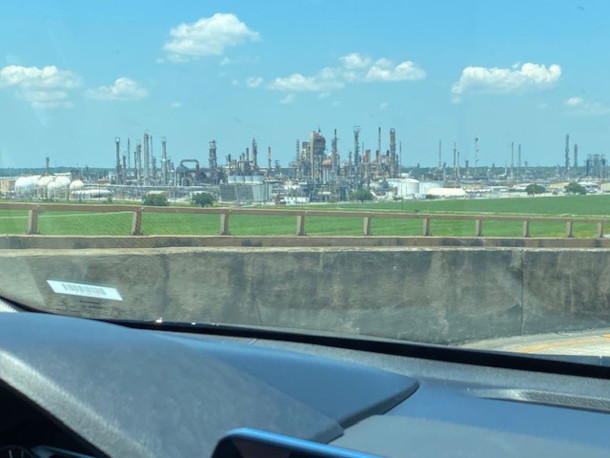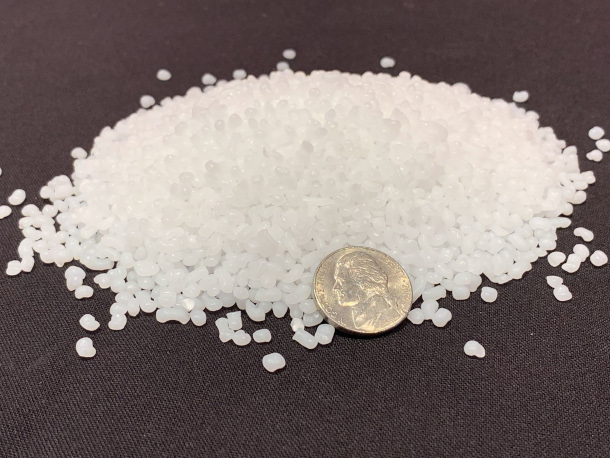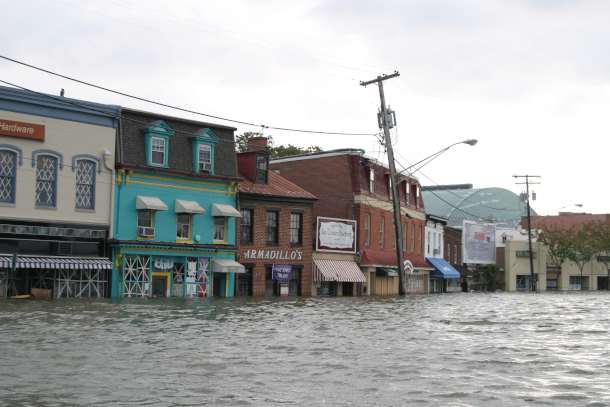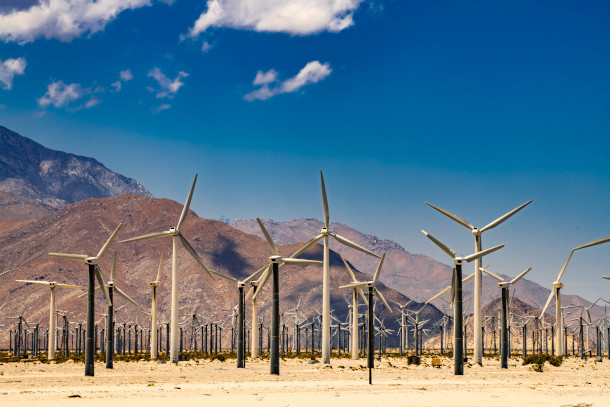Eco-Justice40
Air Date: Week of July 30, 2021

Industry and petrochemical plants in the region along the Mississippi River between Baton Rouge and New Orleans colloquially known as ‘cancer alley.' This image was taken by Heather McTeer Toney during a Moms Clean Air Force visit to the region. (Photo: Heather McTeer Toney)
With yet another deadly chemical plant accident in a low-income neighborhood to underscore the issues, this time in Houston on July 27, the Biden administration has now rolled out details of its environmental justice plan called Justice40. The program aims to share at least 40% of benefits from federal climate and infrastructure spending with disadvantaged communities. Heather McTeer Toney served as the EPA'S Southeast Regional Administrator under President Obama and is now an environmental justice liaison for the Environmental Defense Fund. She joins Host Steve Curwood to discuss the Justice40 Initiative.
Transcript
CURWOOD: From PRX and the Jennifer and Ted Stanley Studios at the University of Massachusetts Boston, this is Living on Earth. I’m Steve Curwood.
Around 7:30 pm on July 27th in the Laporte area of Houston, employees at the LyondellBasell chemical plant suddenly had to flee for their lives:
ABC 13 NEWS REPORTER: Here is what we know right now. About 100,000 pounds of acetic acid was released in the leak Tuesday night. Leaving 2 people dead, more than 40 people were injured there on scene. 30 workers were taken to the hospital following the leak.
CURWOOD: The LyondellBlassell incident was over so quickly there was no need to evacuate residents. But less than a week earlier residents within a half mile of a Dow chemical plant in the same area had to evacuate their homes after a chemical leak posed a risk of an explosion. Fortunately, no one was killed in the Dow chemical release incident. But according to Harris County officials, the closest neighborhoods to these incidents are low-income neighborhoods with white, brown, and black residents suffering a regular onslaught of potential chemical exposures. Polluting industries are routinely cited in low income, environmental justice, communities. Dealing with the risks of industrial chemical pollution in underserved communities is part of the Biden Administration’s plans to address environmental justice in part through infrastructure resources that are in the legislative mix now in Washington. The White House program is called Justice40 because it intends to ensure that at least 40% of the benefits from federal energy and environmental spending reach disadvantaged communities. The administration has named 21 federal programs that will be part of Justice 40 including clean transportation, affordable and sustainable housing, clean energy, and water management. Joining us now for details is Heather McTeer Toney; she served as the EPA's Southeast regional administrator under President Obama and is now an environmental justice liaison for the Environmental Defense Fund. Welcome to Living on Earth Heather!
MCTEER: Thanks so much. It's wonderful to be here with you Steve

Plastic nurdles are tiny pieces of plastic mostly manufactured from ethane cracker plants which are mostly located along low income black and brown communities. (Photo: Mark Dixon, Flickr, CC 0 1.0 Universal)
CURWOOD: So what would the 40% look like? And how is this going to be accounted for do you think?
MCTEER: So that's a great question and I think it's one of the things that the initial guidance is beginning to show us what is the roadmap and what is the outline. The White House engaged a panel of experts, and they're called the White House Environmental Justice Advisory Council or the WHEJAC and these are environmental justice leaders from all walks of life, all parts of the country that represent a very good segment of the American population concerned about environmental and climate justice. And through their advice, we now have an implementation guidance for how we're going to go about seeing the Justice40 implemented. Now I have to stress this is not just for one part of the federal government. This is to ensure that every single agency within the federal government is utilizing benefits to help disadvantaged communities and really sort of spur economic development. So while the federal government is giving us a roadmap it's still incumbent upon us in the communities that's mayors, city council members, state legislators, churches, schools, it's incumbent upon all of us to actually follow the roadmap. So there's some partnership here that is required. And this initial guidance is showing us a number of pilot areas that could potentially be used to start spurring both economic green development, but also really looking at how we can leverage these investments, reduce pollution in communities, and at the same time, think of it as a catalyst for both clean energy jobs, energy efficiency, and moving communities into what you know, we think of now in terms of a green future.
CURWOOD: So you've been the mayor of a town, of a city of Greenville, Mississippi. So talk to me about some of the key areas that this initiative is going to focus on that local government will want to engage with.

Justice40 includes a Flood Mitigation Assistance program, which is a competitive assistance program that provides funding for states, local communities, Federally recognized tribes and territories. The funds can be used to reduce the risk of repetitive flood damage. (Photo: Michael Land, Chesapeake Bay Program, Flickr, CC BY-NC 2.0)
MCTEER: A great example is the sections on training and workforce development combined with remediation and reduction of legacy pollution. There are communities across this country that have dealt with historic pollution, I mean, generational where they have, quite frankly, lived under a cloud of pollution. And so legacy pollution is something where we're talking about reducing these impacts. Well, this Justice40 initiative has funding that is specifically targeted to reducing legacy pollution through things that we know like Brownfields redevelopment or superfund sites, but also things like, you know, reducing farmworkers exposure to pesticides, or reclaiming abandoned mines, and capping orphan wells, which is very important in terms of reducing overall carbon emissions in our country and benefiting our planet. At the same time as a city leader, I would love to be able to take that money and funding and leverage it with training workforce development because while these are good things to do, you still have to educate people in the community on how to do it, and train people in smart technologies and new jobs that can come in and replace some of the things that were the cause of legacy pollution. And so that's where the training and workforce development dollars come in, to increase training for good paying jobs around energy and efficiency. This is something that goes to benefit not only people who are looking for a job, but also employers as a way to give them benefits. And it includes participation of some of the key parts of our community, which include youth or formerly incarcerated individuals. And I love the fact that this Justice40 plan actually identifies in a circular way parts of our communities that can work together.
CURWOOD: So some polluters are very powerful. And I'm thinking of a little further south on the Mississippi River from where you're talking there, a place that's colloquially known as cancer alley. There are more than 100 petrochemical plants along there where people in fenceline communities, often people of color, and with very high cancer rates and other health issues, have for years been looking for justice. This is where they settled and where they want to raise their families and the industry pollution has made it very tough. How do you think President Biden's Justicefor40 initiative will deal with problems of, let's talk directly about cancer alley?

The Justice40 initiative includes a Rural Energy for America Program for the Department of Agriculture, which provides guaranteed loan financing and grant funding to agricultural producers and rural small businesses for renewable energy systems or to make energy efficiency improvements. (Photo: Daxis, Flickr, CC BY-ND 2.0)
MCTEER: You know, I was there for Juneteenth. I and a few other members from Moms Clean Air Force, we were walking up and down the neighborhoods to have conversations with folks--identify not only how we could be of help, but also you know, what were some of the concerns straight from people as they're experiencing it every day. And the things that I heard were not only a need for reducing the pollution and finding ways to put a moratorium on new permits and new facilities concerns around air pollution. But future focus concerns around what are my kids gonna do? What will my grandchildren have as a replacement for jobs, as we are shifting the focus to more things that are pollution free, and less and fewer plastics? I think you said it, right. You're talking about some major major polluters, big companies and industry that are located not just in cancer alley but across the globe. And so it's a true David and Goliath story. And if you've ever been down a cancer alley, you know it's almost breathtaking when you go across the bridge and you just see all of these facilities, you can literally see the change in the air. Well, it's incumbent upon all of us to protect the rights of all people where they are as they exist and ensuring that they have access to clean air, clean land and clean water. And this does that in part by making sure that folks do have the resources that they need to help to reduce that impact.
CURWOOD: So as we're speaking, there have been discussions on Capitol Hill about an infrastructure bill. And what do you see as the intersections when it comes to addressing climate justice and advancing infrastructure legislation?

Heather McTeer Toney is former Mayor of Greenville, MS and Southeast EPA Regional Administrator during the Obama Administration. She currently leads the field program for Moms Clean Air Force. (Photo: Courtesy of Moms Clean Air Force)
MCTEER: I think it has to be a priority for all of us, because the infrastructure is tied to not only our win on climate and really reducing overall global emissions, but also job creation, economy and the future of our country and our children. This infrastructure bill, what it does is it sets us up for a solid future and it is necessary. The Biden administration put forth a plan that is not just bold but is necessary. So I want to definitely see a strong bill come out. But I also recognize that we have to continue working to push and make sure we have investment that's coming from not only all sectors of government, but even our private businesses, philanthropy and our communities. It's going to take all of us.
CURWOOD: Heather McTeer Toney is a former mayor of Greenville, Mississippi Regional Administrator for the Environmental Protection Agency, and now serves as environmental justice liaison for the Environmental Defense Fund. Thank you so much for taking the time with us today.
MCTEER: Thanks so much.
Links
Scientific American | “How Biden’s Environmental Justice Order Might Work”
E&E News | “Exclusive: White House Details Environmental Justice Plans”
Learn more about Heather McTeer Toney
The Guardian | “Chemical Leak in Houston Facility Leaves Two Dead and 30 People Hospitalized”
AP News | “New Infrastructure Bill Must Focus on Climate Activists Say”
The New York Times | “The Infrastructure Plan: What’s In and What’s Out”
ABC 13 | "2 dead, 30 hospitalized in chemical leak at LyondellBasell chemical plant in La Porte"
Living on Earth wants to hear from you!
Living on Earth
62 Calef Highway, Suite 212
Lee, NH 03861
Telephone: 617-287-4121
E-mail: comments@loe.org
Newsletter [Click here]
Donate to Living on Earth!
Living on Earth is an independent media program and relies entirely on contributions from listeners and institutions supporting public service. Please donate now to preserve an independent environmental voice.
NewsletterLiving on Earth offers a weekly delivery of the show's rundown to your mailbox. Sign up for our newsletter today!
 Sailors For The Sea: Be the change you want to sea.
Sailors For The Sea: Be the change you want to sea.
 The Grantham Foundation for the Protection of the Environment: Committed to protecting and improving the health of the global environment.
The Grantham Foundation for the Protection of the Environment: Committed to protecting and improving the health of the global environment.
 Contribute to Living on Earth and receive, as our gift to you, an archival print of one of Mark Seth Lender's extraordinary wildlife photographs. Follow the link to see Mark's current collection of photographs.
Contribute to Living on Earth and receive, as our gift to you, an archival print of one of Mark Seth Lender's extraordinary wildlife photographs. Follow the link to see Mark's current collection of photographs.
 Buy a signed copy of Mark Seth Lender's book Smeagull the Seagull & support Living on Earth
Buy a signed copy of Mark Seth Lender's book Smeagull the Seagull & support Living on Earth

